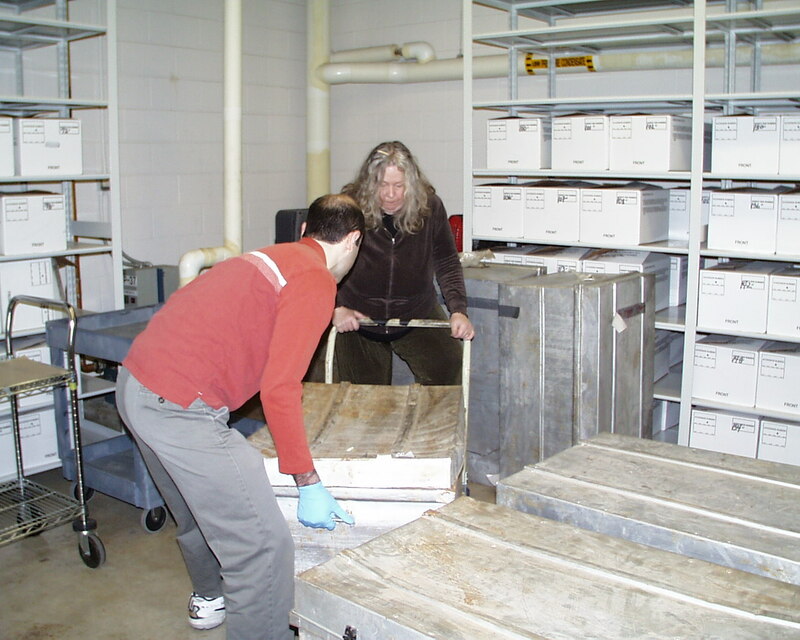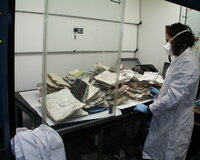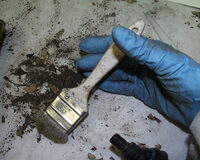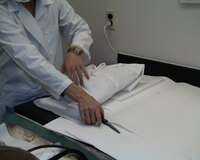Assessment and Planning
Phase 2 Overview
Overview
The National Endowment for the Humanities, Division of Preservation and Access, awarded the Center for Jewish History approximately $98,000 to accomplish the second phase of the project.
- Conservators gained basic physical control over the Iraqi Jewish Archive, that is, removing items from the metal trunks, determining the types of items in the collection, assessing condition, and photographing covers and title pages.
- Catalogers developed basic cataloging or preliminary descriptions to gain intellectual control.
- Subject experts evaluated each entry to provide recommendations on the priorities for the project and options for providing access to the materials through digitization and display (in exhibition).
Basic Preservation Actions and Cataloging
Assessment and Housing
The team unpacked the trunks and assessed and documented the condition of each item.
Initial Mold Remediation
Although vacuum freeze-drying had rendered the mold inactive, the presence inactive mold spores on many of the books and documents was a health risk. To permit some handling and photography, the conservation team cleaned off some of the exterior mold from books and document binders. They worked in a fume hood using a HEPA-filtered vacuum and soft brushes in a dedicated mold-remediation room.
Title Page Photography and Database Creation
Following preliminary mold remediation, title pages and book covers for each item were digitally photographed and added to the project database; an “entry” was either one book or one binder containing multiple, sometimes hundreds of documents. The 3,846 database entries comprise more than 2,700 books, tens of thousands of documents, bags of fragments, parchment fragments of Torah and Book of Esther scrolls, and a few artifacts.
Preliminary Description of Items
The photos enabled Hebrew and Arabic catalogers, directed by the Center for Jewish History, to “see” the books and documents via the web; they could then provide preliminary descriptive and, where feasible, cataloguing information for the database. Each entry was housed in acid-free paper and boxes for improved support and storage.
Expert Recommendations
To determine the next steps in preserving and eventually sharing these materials with a world wide public, a group of subject-matter experts met in May 2010 to review the materials in the Iraqi Jewish Archive database and discuss preservation priorities for the collection.
The experts—knowledgeable in Jewish history, Iraqi and Middle Eastern history, the Iraqi Jewish community, and Hebraic rare books and printing—assessed all items in the collection from the perspectives of relative curatorial and archival importance, intrinsic value, rarity, exhibit potential, and priorities for digitization.
The subject-matter experts endorsed the following recommendations, which provided the conceptual framework for the National Archives to develop phase 3 of the Iraqi Jewish Archive preservation and access plan:
- Digitize all archival documents. All documents should be digitized and made available online—these unique items will be interesting to social historians, historians of Iraq and the Middle East, and Jewish communities, among others.
- Digitize selected books. Less than 18 percent of the total books are important due to their content, rarity, and other special characteristics and should be digitized and made available online. The books more commonly found in libraries or online collections do not warrant further conservation treatment or digitization.
- Make the contents of the collection available worldwide in a database. The Iraqi Jewish Archive as a whole entitiy is also important as a collection of the books and documents, brought together at the Mukhabarat, the Iraqi intelligence headquarters, which reflect the community and the history and events of the period.
- Create an exhibit to tell the story of the 2,500-year-old Iraqi Jewish community, the salvage of the collection, and its preservation.
This approach ensures that the unique information about the Jewish community in Baghdad can be broadly shared, while utilizing scarce resources wisely.
The experts who made these recommendations included:
- Michael Grunberger, Director of Collections, United States Holocaust Memorial Museum
- Jane Gerber, Professor of History, City University of New York
- Maurice Shohet, member of the Iraqi Jewish community, later President of the World Organization of Jews from Iraq (WOJI)
- Bernard Cooperman, Louis L. Kaplan Professor of Jewish History, University of Maryland
- Laura E. Leone, Director of Library Systems, Center for Jewish History
- Reeva Spector Simon, Associate Director, Middle East Institute, Columbia University; Professor of History, Yeshiva University
- Baidaa Abdulhareem, Third Secretary, Embassy of the Republic of Iraq, United States
A copy of the database and the review criteria were also provided to Saad Eskander, Director General of the Iraqi National Library and Archives (INLA), to solicit INLA’s perspective regarding the item-level review.





